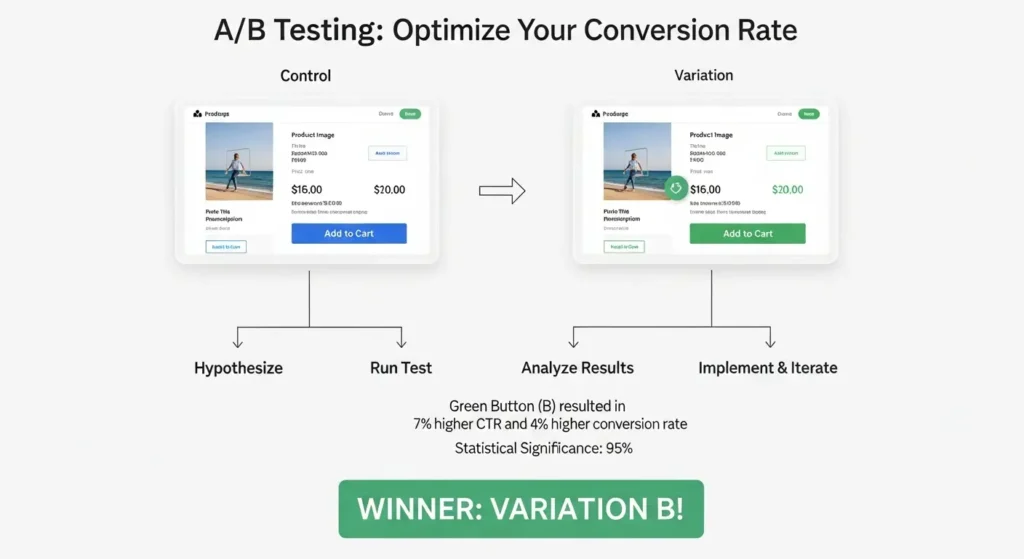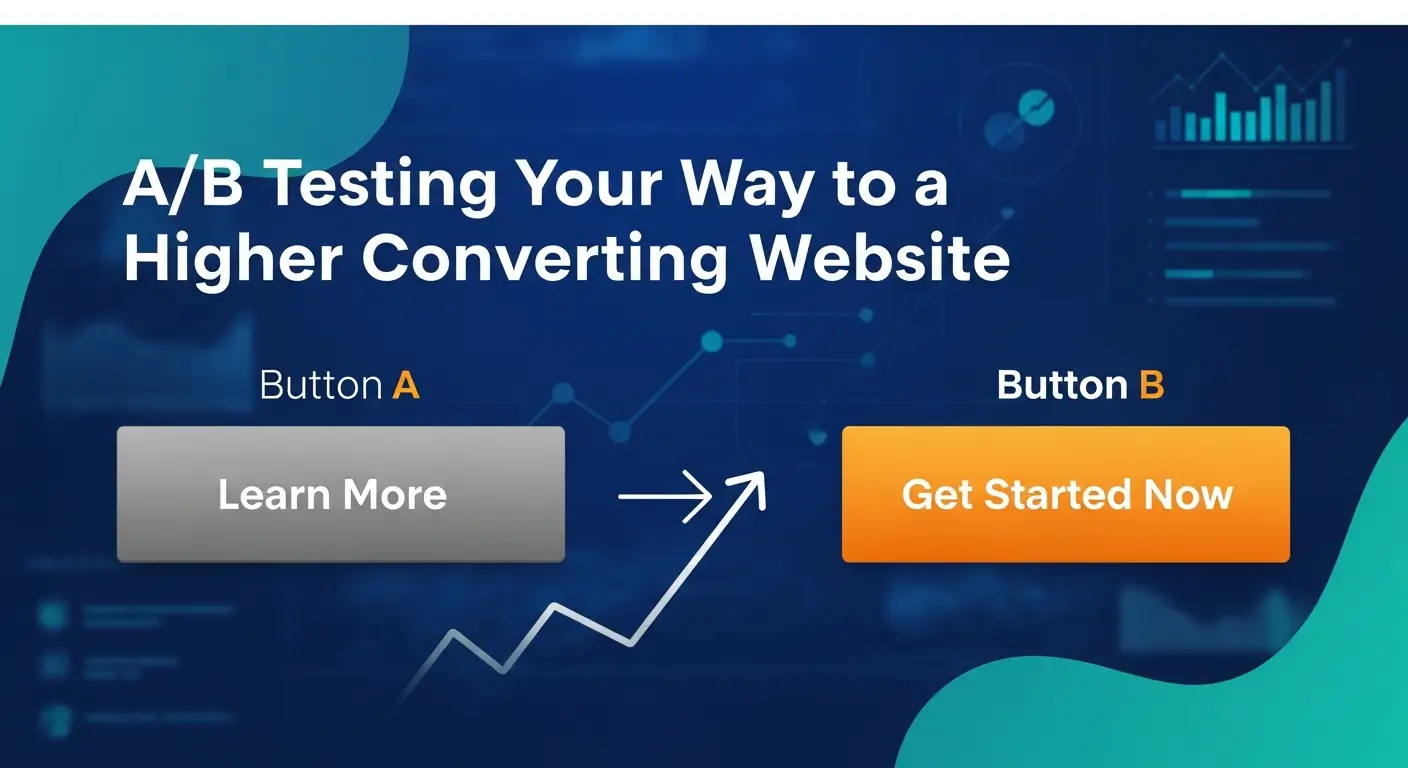In the competitive digital landscape, a website isn’t just a brochure; it’s a powerful sales tool, a lead generation engine, and a customer service portal all rolled into one. But simply having a website isn’t enough. To truly succeed, your website needs to be a high-converting machine, constantly enticing visitors to take desired actions, whether it’s making a purchase, signing up for a newsletter, or filling out a contact form. This is where the magic of A/B testing comes in – a scientific approach to understanding your audience and optimizing your website for maximum impact.
What is A/B Testing and Why Does it Matter for Your Website?
At its core, A/B testing (also known as split testing) is a method of comparing two versions of a webpage or app element to see which one performs better. Imagine you have an original version (the “control” or “A” version) and a modified version (the “variation” or “B” version). You split your website traffic, sending a portion to each version, and then analyze the results to determine which version achieves a higher conversion rate.
Why does this matter so much for your website? Because even seemingly minor changes can have a significant impact on user behavior and, ultimately, your bottom line. Without A/B testing, you’re essentially guessing what your audience wants, relying on assumptions or best practices that may not apply to your specific users. A/B testing removes the guesswork, providing data-driven insights that empower you to make informed decisions about your website’s design, content, and functionality. For any forward-thinking web development company, integrating A/B testing into their project lifecycle is no longer an option, but a necessity for delivering truly optimized solutions.
Key Benefits of A/B Testing:
- Increased Conversion Rates: The most obvious benefit is the direct impact on your website’s ability to convert visitors into customers or leads.
- Improved User Experience (UX): By understanding what resonates with users, you can create a more intuitive and enjoyable experience.
- Reduced Bounce Rate: Optimizing elements that cause users to leave can keep them engaged longer.
- Higher Return on Investment (ROI): Small, data-backed changes can lead to substantial gains without significant overhauls.
- Deeper Understanding of Your Audience: A/B testing provides invaluable insights into your users’ preferences, pain points, and motivations.
- Mitigation of Risk: Test small changes before rolling them out site-wide, minimizing potential negative impacts.
The Anatomy of a Successful A/B Test: From Hypothesis to Implementation
A/B testing isn’t just about throwing two versions against a wall and seeing what sticks. A structured approach is crucial for reliable results and actionable insights. Here’s a breakdown of the key steps:
1. Formulate a Hypothesis
Before you change a single pixel, you need a clear hypothesis. This is your educated guess about what change will lead to a specific improvement. A good hypothesis follows an “If…then…because…” structure.
- Example: “If we change the call-to-action button color from blue to orange, then we will see a 15% increase in clicks, because orange is a more vibrant and attention-grabbing color that stands out better against our website’s existing palette.”
2. Identify What to Test
Almost any element on your website can be A/B tested. The key is to focus on elements that have a direct impact on conversion goals.
Common A/B Testing Elements:
- Headlines: The first thing visitors see, impacting engagement.
- Call-to-Action (CTA) Buttons: Text, color, size, placement.
- Page Layout and Design: Overall structure, element placement, whitespace.
- Images and Videos: Which visuals resonate most with your audience?
- Pricing Models: Different ways to display costs or offers.
- Form Fields: Number of fields, labels, design.
- Product Descriptions: Length, tone, information provided.
- Navigation: Menu structure, labels, ease of use.
- Social Proof: Testimonials, reviews, trust badges.
Start with elements that you believe are underperforming or have the most significant potential for improvement based on analytics data (e.g., high exit rates on a specific page, low click-through rates on a CTA).
3. Create Your Variations
Once you know what you’re testing and your hypothesis, create the “B” version(s) of your chosen element. Remember to only changeone elementper test to ensure you can accurately attribute any performance differences to that specific change. If you change multiple things at once, you won’t know which specific alteration caused the improvement (or decline).
4. Set Up Your A/B Testing Tool
Several powerful A/B testing tools are available, such as Google Optimize (currently being sunsetted, but alternatives like Google Analytics 4 offer integration with other testing platforms), Optimizely, VWO, and Adobe Target. These tools allow you to:
- Define your control and variation pages/elements.
- Split traffic between versions.
- Track key metrics (e.g., clicks, conversions, time on page).
- Analyze the results with statistical significance.
5. Run the Test
Launch your test and let it run until you achieve statistical significance. This is crucial because it tells you that the observed difference in performance between your versions is not due to random chance. Don’t stop a test early just because one version appears to be winning; premature conclusions can be misleading. The duration of the test depends on your website traffic and the magnitude of the expected change. Most tools will indicate when enough data has been collected.
6. Analyze and Implement
Once the test concludes and statistical significance is reached, analyze the results.
- Identify the Winner: Which version performed better against your conversion goal?
- Understand “Why”: Beyond just knowingwhatwon, try to understandwhyit won. This provides deeper insights into your audience.
- Implement the Winner: If your variation was the winner, implement it permanently on your website.
- Document and Learn: Keep a record of your tests, hypotheses, results, and learnings. This builds a valuable knowledge base for future optimization efforts.
- Iterate: A/B testing is an ongoing process. The winning variation becomes the new control, and you start the cycle again, always seeking new ways to improve.
Best Practices for Maximizing Your A/B Testing Success
To truly leverage the power of A/B testing, keep these best practices in mind:
- Focus on Impactful Elements: Prioritize testing elements that are critical to your conversion funnel and have the potential for significant gains.
- Test One Variable at a Time: Isolate your changes to accurately attribute results. If you need to test multiple changes simultaneously, consider multivariate testing, which is more complex but can handle more variables.
- Ensure Statistical Significance: Never make decisions based on insufficient data. Wait until your testing tool confirms statistical significance.
- Consider External Factors: Be aware of external influences during your test (e.g., marketing campaigns, seasonality, news events) that could skew results.
- Segment Your Audience: Sometimes, a variation might perform better for a specific segment of your audience (e.g., new visitors vs. returning visitors, mobile vs. desktop users).
- Don’t Be Afraid of “Failed” Tests: A test where the variation doesn’t outperform the control isn’t a failure. It’s a valuable learning experience that tells you whatdoesn’twork for your audience.
- Continuously Test: Website optimization is not a one-time project; it’s an ongoing journey. The digital landscape evolves, and so should your website.
Here’s an example of an A/B test in action:
Consider an e-commerce website where the product page has a prominent “Add to Cart” button. The marketing team hypothesizes that a larger, green button will convert better than the current smaller, blue button. They set up an B test: 50% of traffic sees the blue button (control), and 50% sees the green button (variation). After two weeks, the green button version shows a 7% higher click-through rate to the cart and a 4% higher conversion rate to purchase, with statistical significance. The team then implements the green button permanently.

Common Pitfalls to Avoid
Even with the best intentions, A/B testing can go awry. Be mindful of these common pitfalls:
- Testing Too Many Variables at Once: This makes it impossible to pinpoint what caused the change.
- Stopping Tests Too Early: Leading to false positives or negatives due to insufficient data.
- Ignoring Statistical Significance: Making decisions based on random fluctuations rather than genuine performance differences.
- Not Having a Clear Hypothesis: Without a clear “why,” you’re just randomly changing things.
- Testing Insignificant Elements: While youcantest anything, focus your efforts on elements that truly impact user behavior.
- Failing to Segment Results: Different user groups might react differently to the same change.
- Not Documenting Learnings: Reinventing the wheel with every new test because previous insights weren’t recorded.
The Synergy of A/B Testing and SEO
While A/B testing primarily focuses on conversion rates, it also has a symbiotic relationship with SEO. A higher converting website often translates to better SEO performance. How?
- Improved User Engagement: A/B tests that lead to better UX (e.g., lower bounce rate, higher time on page, more clicks) send positive signals to search engines, indicating your content is valuable and relevant.
- Better Content Relevance: By testing headlines, descriptions, and content layouts, you can identify what truly resonates with your audience, leading to more engaging content that satisfies search intent.
- Faster Page Load Times: While not a direct A/B test, optimizing images or reducing script sizes based on A/B testing insights can indirectly improve page speed, a crucial SEO ranking factor.
- Enhanced Mobile Experience: A/B testing for mobile-specific elements ensures a seamless experience across devices, which is critical for mobile-first indexing.
- Optimized CTAs: While primarily for conversions, well-optimized CTAs can guide users to other valuable content on your site, improving internal linking and overall site structure.
By creating a website that users love and engage with, you naturally improve many of the factors that search engines value, leading to higher rankings and more organic traffic. Finding a reliable web development company in Noida that understands the nuances of both A/B testing and SEO can be a game-changer for your online presence.
Conclusion
A/B testing is not just a tool; it’s a philosophy of continuous improvement. It transforms your website from a static entity into a dynamic, data-driven engine that constantly adapts and optimizes for your audience. By systematically testing, analyzing, and implementing changes, you gain unparalleled insights into user behavior, unlock hidden conversion potential, and ultimately build a more successful online presence.
Don’t leave your website’s performance to chance. Embrace the power of A/B testing and start making data-backed decisions that will elevate your conversion rates and propel your business forward.
Ready to transform your website into a conversion powerhouse?Contact us today for a free consultation, and let’s explore how a tailored A/B testing strategy can unlock your website’s full potential and drive measurable growth for your business!

